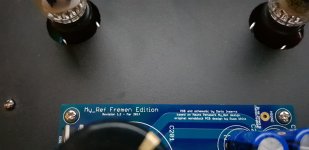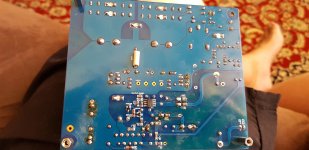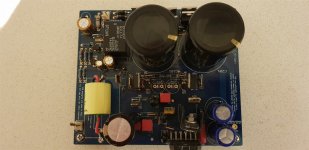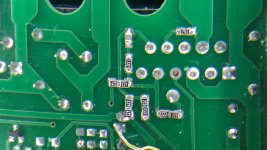By doing the abovementioned, you'll reach dynamics, transparency, imaging, separation, contrast, timbre that are way above standard my_ref and make it comparable to commercial amps of much higher cost (without being "thin" as most gainclones are).
My My_ref FE, after these mods, is clearly superior to my S-AKSA amp and comparable to my 6C33C OTL monoblocks, even better in some parameters. Just try to believe.
Luca, it seems you're gone way past my recommendations... 😉
It would be nice to have some part numbers for the diodes, maybe I will give them a try.
Nevertheless none of these mods (including audiophile alternates in official BOM) is necessary to have a terrific sounding My_Ref FE, with plenty of dynamic and output volume.
With Peter's case we should go to the basics, an industrial BOM My_Ref FE can't sound with low output volume...there is a problem.
Luca, it seems you're gone way past my recommendations... 😉
To be honest, most of the mods i suggested are from Joseph K, that i strongly thank 😀
It would be nice to have some part numbers for the diodes, maybe I will give them a try.
I used the following:
VS-HFA08TB60-N3 Vishay Semiconductors | Mouser Italia
But you can use the following for slightly higher neutrality/detail and slightly less warmth:
C3D08065A Wolfspeed / Cree | Mouser Italia
I like hexfred more as they're more tube-rectifier sounding, but that's upon my taste...
Both are way better than MUR820, anyway.
Nevertheless none of these mods (including audiophile alternates in official BOM) is necessary to have a terrific sounding My_Ref FE, with plenty of dynamic and output volume.
With Peter's case we should go to the basics, an industrial BOM My_Ref FE can't sound with low output volume...there is a problem.
I agree, low volume makes me think of some problem, too.
But i have to confirm that standard My_ref sounds a bit like struggling to get the music out when compared to some gainclones or class D amps, it sounds like a tube amp, full bodied and warm, but not so "live" or "fast" as other ss amps.
Replacing LM318 with OPA827 (or even 4627) shifts it to a higher gear, music flows much better and clearer. The other mods i listed are the nitro boost!
Z-foils on the pump and glass caps are killer mods too, please don't underestimate them. Isabellenhuttes instead of Caddocks lift the last veil.
The sum of them all is a cooperation for an unexpected SQ level you can't find in a commercial amp of this cost (and dimensions!).
Obviously, that is possible thanks to the exceptionally good project, that never shows its limits!
Last edited:
The HexFRED you linked is in End of Life, this should be the replacement:I used the following:
VS-HFA08TB60-N3 Vishay Semiconductors | Mouser Italia
But you can use the following for slightly higher neutrality/detail and slightly less warmth:
C3D08065A Wolfspeed / Cree | Mouser Italia
I like hexfred more as they're more tube-rectifier sounding, but that's upon my taste...
Both are way better than MUR820, anyway.
VS-HFA08TB60-M3 Vishay Semiconductors | Mouser Italia
Since the price is similar to the MUR820 can be a replacement for the standard BOM.
Can you describe the differences between MUR820 and HFA08TB60? I don't know how a tube rectifier sounds... 😉
The word 'struggling' doesn't sound correct to me referred to the My_Ref FE... I can agree that a better opamp could increase speed and liveness but my My_Ref FE, in my setup, never seemed to 'struggle' at anything...But i have to confirm that standard My_ref sounds a bit like struggling to get the music out when compared to some gainclones or class D amps, it sounds like a tube amp, full bodied and warm, but not so "live" or "fast" as other ss amps.
hi here is my pcb
v1.2 as in my archive.
Wow... you have more Bulk metal foils than me.
The input caps... what are they? Auricaps?
And C1, C2?
Did you specs for your loudspeakers?
Did you try your amp with different loudspekers?
Can you describe the differences between MUR820 and HFA08TB60? I don't know how a tube rectifier sounds... 😉
Not easy to do... we go into personal perceptions here, very difficult to find the right words. I don't think the difference in sound is measurable.
Tube rectifiers, in my experience, give a full and warm body to sound; in addition, everything sounds more similar to real sounds, expecially natural/organic sources (human voices, acoustic instruments, etc...). But that's not true for every tube rectifier, just the best sound this way.
Anyway, hexfred diodes sound similar, so by evidence that particular sound is not due to tube technology... then i don't know what exactly is involved here. 😕
The word 'struggling' doesn't sound correct to me referred to the My_Ref FE... I can agree that a better opamp could increase speed and liveness but my My_Ref FE, in my setup, never seemed to 'struggle' at anything...
We're talking in relative terms here. Sure a standard My_ref is not "struggling" to output music when compared to a sub 1000 USD tube amp, except very few that shine in this; but when compared to a good class D power amp or a much higher cost tube/ss power amp i hear a "slower" music, less "push", as if My_ref found it hard to let the music out. A bit hampered. This is much worse if you don't use a good preamp, something like low watt SE power amps.
OPA827 gives My_ref a much easier and clear sound, but you have to test it to understand the difference, as in absolute terms standard My_ref is not so "struggling", but it is in relative terms.
That's why i told Peter he probably doesn't have higher expectations, but different expectations instead, i think he was envisioning a different sound character because he identified My_ref as a Gainclone (that it is, but doesn't sound like). Harmonious and equilibrate sound is not easy to value initially.
last one
Uhmmm... Many z-foils but cheap coupling caps...
Input coupling caps are really important for SQ, maybe one of the most important component. If your preamp has output coupling caps, then you can try bypassing My_ref imput ones, that would be easy and cheap.
If you can't, then you need better caps - nothing worse than Mundorf Supremes IMHO.
peterma,
I like using Peerless woofers too. The trouble is that their 12" line varies quite a bit in SPL. Some models are as high as 90 dB/W and I've seen other down around 84 dB/W. So depending on which you used, there could be quite a difference volume setting. All of these My_Ref designs are at about 30 dB gain which is slightly higher gain than the old chipamps.com (BrianGT) gainclone. Which gainclone were you referring to? If your standard gainclone needs significantly lower volume setting than the FE, then there may be a problem as Dario suggests. First place to double check would be the values of R7 (12k) and R10 (390R).
A question of curiosity. On the bottom of your board, there is a white cylinder at J1. Am I assuming correctly that the white is a length of shrink tube or equivalent for insulation?
Jac
I like using Peerless woofers too. The trouble is that their 12" line varies quite a bit in SPL. Some models are as high as 90 dB/W and I've seen other down around 84 dB/W. So depending on which you used, there could be quite a difference volume setting. All of these My_Ref designs are at about 30 dB gain which is slightly higher gain than the old chipamps.com (BrianGT) gainclone. Which gainclone were you referring to? If your standard gainclone needs significantly lower volume setting than the FE, then there may be a problem as Dario suggests. First place to double check would be the values of R7 (12k) and R10 (390R).
A question of curiosity. On the bottom of your board, there is a white cylinder at J1. Am I assuming correctly that the white is a length of shrink tube or equivalent for insulation?
Jac
There are some differences.. Not dead serious but there are.
You still have the classic compensation scheme;
So a first step could be to buy directly the IsabellenHutte .33 ohm resistors suggested by Luca, which we found a nice advance with respect to the original Caddocks in R3 position.
It would re-invigorate the blood cells in your amp..
Should redo all the necessary rev A changes in the compensation scheme;
Try to put a bit better input cap.
Changing the rectifiers to Cree SIC C3D06065A (or else; we found this to be the cheapest approach to the Sic world (to this sick world..))
They bring an even stricter grip, resolution, firmer presentation. More energy.
When we did it first this was the impression; I kept saying it's like changing the feedback from susumu to a Z-foil..
The diodes and the IH in R3 gives a strong awakening to the sound.
The elimination of the susumu RG parts from the rest of the feedback chain (47k;22k in the current pump) opens up the sound nicely; for me this is the part where a part of compression creeps in (also the R3 is an extremely sensitive feedback position; there strong currents are generating very delicate deviations in the feedback loop);
As usual, and sadly true, the solution for the current pump is .. Z-foils... and the best, possibly more stable & available resistor in R3 - - which is Powertron or the german version, IsabellenHutte. Right after VPG CSNG power resistors... 🙁(
and finally the much better PSRR parameters, much less common mode distortion of the substitute opamps (ADA4627, OPA827, and most recently OPA828) together with ~zero input bias current brings the possibility to eliminate C9 9which is a nice overall gain..) without offset problems.
I have heard the amplifier of Luca72; it is gorgeous. One does not want to stop listening.
His recipe is the best direct access to a very very good sound with relatively small costs - - from the position where You are now.
Ciao, George
You still have the classic compensation scheme;
So a first step could be to buy directly the IsabellenHutte .33 ohm resistors suggested by Luca, which we found a nice advance with respect to the original Caddocks in R3 position.
It would re-invigorate the blood cells in your amp..
Should redo all the necessary rev A changes in the compensation scheme;
Try to put a bit better input cap.
Changing the rectifiers to Cree SIC C3D06065A (or else; we found this to be the cheapest approach to the Sic world (to this sick world..))
They bring an even stricter grip, resolution, firmer presentation. More energy.
When we did it first this was the impression; I kept saying it's like changing the feedback from susumu to a Z-foil..
The diodes and the IH in R3 gives a strong awakening to the sound.
The elimination of the susumu RG parts from the rest of the feedback chain (47k;22k in the current pump) opens up the sound nicely; for me this is the part where a part of compression creeps in (also the R3 is an extremely sensitive feedback position; there strong currents are generating very delicate deviations in the feedback loop);
As usual, and sadly true, the solution for the current pump is .. Z-foils... and the best, possibly more stable & available resistor in R3 - - which is Powertron or the german version, IsabellenHutte. Right after VPG CSNG power resistors... 🙁(
and finally the much better PSRR parameters, much less common mode distortion of the substitute opamps (ADA4627, OPA827, and most recently OPA828) together with ~zero input bias current brings the possibility to eliminate C9 9which is a nice overall gain..) without offset problems.
I have heard the amplifier of Luca72; it is gorgeous. One does not want to stop listening.
His recipe is the best direct access to a very very good sound with relatively small costs - - from the position where You are now.
Ciao, George
Last edited:
Instead of costly Z-foils in the bridge, we have also found a quite good solution, still with more human cost. The new Susumu RS series for audio.
There are problems: they are available (Mouser) only certain size and parameters (precision).
Though we found that pieces from the same strip are closer to each other less than 0.1 %, in practice (tested with precise benchtop meter)
So they can be used; they also come in 0805 only -- this is a more serious problem.. though.. with a lot of blood swear..t and tears - something like this can be done:
There are problems: they are available (Mouser) only certain size and parameters (precision).
Though we found that pieces from the same strip are closer to each other less than 0.1 %, in practice (tested with precise benchtop meter)
So they can be used; they also come in 0805 only -- this is a more serious problem.. though.. with a lot of blood swear..t and tears - something like this can be done:
Attachments
Last edited:
the in- famous quartets (hi there, Jac 😀) )
I had in different amps for a while - and have to admit, it grew on me.
Ciao, George
I had in different amps for a while - and have to admit, it grew on me.
Ciao, George
Out of scope
Guys...
I understand that some of you explored some worthwhile upgrades to the My_Ref FE but here we have a builder with a problem that usually it's not present.
The My_Ref FE sounds already terrific as is and Peter's experience it's different.
It's worthless proposing new part upgrades, he already has a lot of audiophiles parts, without excluding first other problems, like loudspeakers that could need a much more powerful amp.
Please stop here.
When his amp will start to sing as it should then will be, eventually, upgrade time.
None of the upgrades, apart using My_Evo Rev. A compensation, changes how the amp drives loudspeakers
Guys...
I understand that some of you explored some worthwhile upgrades to the My_Ref FE but here we have a builder with a problem that usually it's not present.
The My_Ref FE sounds already terrific as is and Peter's experience it's different.
It's worthless proposing new part upgrades, he already has a lot of audiophiles parts, without excluding first other problems, like loudspeakers that could need a much more powerful amp.
Please stop here.
When his amp will start to sing as it should then will be, eventually, upgrade time.
None of the upgrades, apart using My_Evo Rev. A compensation, changes how the amp drives loudspeakers
Last edited:
Dario.. one question comes to mind : are we sure he has a technical problem?
I am not at all...
Ciao, George
I am not at all...
Ciao, George
Dario.. one question comes to mind : are we sure he has a technical problem?
I am not at all...
Ciao, George
George, did you ever encountered a My_Ref, even the original one, that doesn't drive loud loudspeakers with reasonable sensitivity?
It's possible that the My_Ref is not powerfull enough to drive Peter's loudspeakers, in this case any part swap would not help.
To clarify things, I would suggest a little test to Peter:
grab a reasonable quality multimeter; set it to AC volts range;
place it accross on the amplifier speaker outputs;
generate with some software, possibly accross a volume control, a 400Hz tone (still Ok for multimeters)
regulate with the input volume control, or software volume control the output, until it measures 6,35 V (In AC settings, which is ~~= 6,35Vrms)
In this case, porting the multimeter to directly accross the input pins, it should sign ;
200mV (~ Vrms)
The amp should not be connected to anything on the output.
Ciao, George
grab a reasonable quality multimeter; set it to AC volts range;
place it accross on the amplifier speaker outputs;
generate with some software, possibly accross a volume control, a 400Hz tone (still Ok for multimeters)
regulate with the input volume control, or software volume control the output, until it measures 6,35 V (In AC settings, which is ~~= 6,35Vrms)
In this case, porting the multimeter to directly accross the input pins, it should sign ;
200mV (~ Vrms)
The amp should not be connected to anything on the output.
Ciao, George
Another George
Dario,
I have seen issues with a My_Ref in the original build. I guess there is a chance this amplifier is the recent design.
Using capacitor coupled tube preamps I had this problem. Was using a 2 ufd coupling cap for cost/size/availability reasons. Poor match. Replaced with a 8 ufd and it sang. The input cap on the M_Ref was either 1 ufd or 0.47. Was using 1 ufd and Mauro lectured me on changing things without knowing the full parameters effected. So split the difference. Changed to 0.47 and it sounded the same.
Some speakers may not like the high output impedance. This is where Rev A helps too.
BTW, where is a source for these better 0.33 ohm resistors? A have always used the big Dale current sense resistors in 0.536 ohms. No inductance and 5 watt with no heat sinks. But it will require parallel combo to get to 0.33. Plus huge. Ended up using a better spec resistor like Caddock in the Fremen.
Also these better Satsuma resistors. Can they be an option for the SM installed boards? I used S102 in these positions with through hole components. Not sure it was better than tight spec Dale RN-55E resistors, but way ahead of generic metal film.
George, did you ever encountered a My_Ref, even the original one, that doesn't drive loud loudspeakers with reasonable sensitivity?
It's possible that the My_Ref is not powerfull enough to drive Peter's loudspeakers, in this case any part swap would not help.
Dario,
I have seen issues with a My_Ref in the original build. I guess there is a chance this amplifier is the recent design.
Using capacitor coupled tube preamps I had this problem. Was using a 2 ufd coupling cap for cost/size/availability reasons. Poor match. Replaced with a 8 ufd and it sang. The input cap on the M_Ref was either 1 ufd or 0.47. Was using 1 ufd and Mauro lectured me on changing things without knowing the full parameters effected. So split the difference. Changed to 0.47 and it sounded the same.
Some speakers may not like the high output impedance. This is where Rev A helps too.
BTW, where is a source for these better 0.33 ohm resistors? A have always used the big Dale current sense resistors in 0.536 ohms. No inductance and 5 watt with no heat sinks. But it will require parallel combo to get to 0.33. Plus huge. Ended up using a better spec resistor like Caddock in the Fremen.
Also these better Satsuma resistors. Can they be an option for the SM installed boards? I used S102 in these positions with through hole components. Not sure it was better than tight spec Dale RN-55E resistors, but way ahead of generic metal film.
- Home
- Amplifiers
- Chip Amps
- My_Ref Fremen Edition - Build thread and tutorial




